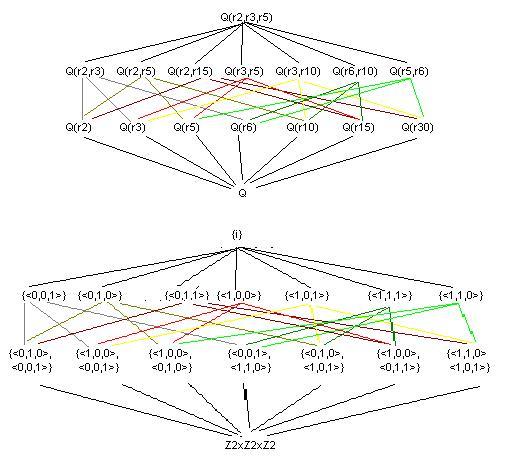11.2.14
I will write rn for the square root of n.
Q(r2,r3,r5)
GalQ(Q(r2,r3,r5)) is isomorphic to Z2xZ2xZ2
via the isomorphism
f(t)=(a,b,c) where a=0 if t(r2)=r2, a=1, if t(r2)=-r2,
b=0 if t(r3)=r3, b=1, if t(r3)=-r3, c=0 if t(r5)=r5, c=1, if t(r5)=-r5.

11.3.1a
The sequence
Q, Q(r7), Q(r7,r5), Q(r7,r5,rr(1+r7)), Q(r7,r5,rr(1+r7)),rr(2+r5)) shows that
Q(r7,r5,rr(1+r7)),rr(2+r5)) is a radical extension of Q. Clearly rr(1+r7))-rr(2+r5) is in
Q(r7,r5,rr(1+r7)),rr(2+r5)).
11.3.3
Suppose K is a radical extension of F.
Then there are sequences
F=F0,F1,...,Fn=K
and u1,...,un-1 s.t.
Fi(ui)=Fi+1.
And for some power ni-1 of ui-1 is in Fi-1.
This means that ui is a root of a polinomial of the form
x^(ni)-a where a is in Fi. This
means [Fi:Fi-1] is at most
ni-1.
[K:F]=[Fn:Fn-1]...[F1:F]
is less than n0n1...nn-1
so [K:F] is finite.
11.3.5a
Easy to check that H is normal in A4.
We know A4 is normal in S4
and |S4/A4|=2, therefore
S4/A4=Z2 so is abelian.
|A4/H|=[A4:H]=3, so
A4/H=Z3.
Obviously {e} is normal in H and H is of order 4 so it must be Z4 or Z2xZ2. Both
are abelian. So the sequence S4,A4,H,{e}
shows that S4 is solvable.
11.3.7e
6'th roots of unity are cos(2tPi/6)+ isin(2tPi/6), where t is in {0,1,2,3,4,5}.
By substituting t will get the 6'th roots of unity are:
+/- 1 , (+/- 1 +/- i sqrt(3))/2
